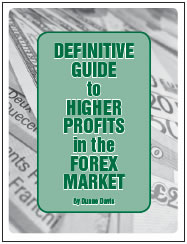.jpg)
Follow
Us:    
|
Mark Your Calendars…
We Have TWO Exciting Webinars
TODAY, November 1st at 3:30pm CDT, join Wendy Kirkland for a FREE educational webinar on options trading.
Don't miss out on this chance to learn from Wendy!
You still have time to join
Save Your Space Now!
Then, join Dr. Duke for his FREE educational webinar on options trading taking place on November 7th at 3:30pm CDT.
Space is limited… Reserve your spot now and start learning!

|
|
Duane Davis has spent the past 25 years testing and fine-tuning trading systems. Scientific research conducted by his firm, Investment Software Systems, is behind several of the most successful systems on the market.
 |
Comparing a Wide Variety
of Trading Systems
I Discovered 26 Conditions
that Apparently NEVER Change

After decades of running complex simulations on a variety of trading systems I came to realize there are certain market “behaviors” that supersede even the most sophisticated technical analysis.
In a monumental undertaking that picks up where other research leaves off, I compared patterns of convergence between every system with which I’d ever been involved.
Analyzing each factor with meticulous care, I uncovered 26 consistent ‘coincidences’ that seem to cross all system boundaries to reoccur time and time again.
|
|

Better
Business Bureau
 |
|
Click on authors name
to learn more
|
| |
|
|
Big things are just beginning to happen in the nation’s capital.
We’ve already talked a lot about how to trade defense spending bills, infrastructure, and even how to trade the gun stocks. Now, though, we have an opportunity to trade potential tax cuts.
Just the other day, the Senate passed a $4 trillion budget that now lays the groundwork for promised tax legislation. That new plan provides for $1.5 trillion over the next decade in debt-financed tax cuts. And Republicans believe they can push it through by year-end. In this issue, we look at how the new tax legislation can produce profitable market opportunities.
Next, Lee Gettess provides his predictions for both the stock and bond markets this week.
Then, Inside Trading brings you Duane Davis who explains why it is best to stay away from profit targets.
Last, Wendy Kirkland covers her Prime Entry Profits (PEP) Rally Newsletter.
Enjoy!
Adrienne LaVigne
TradeWins Publishing
 |
|
Trump Trade: How to Trade a Potential Tax Cut
by
TradeWins Publishing
Big things are just beginning to happen in the nation’s capitol.
We’ve already talked a lot about how to trade defense spending bills, infrastructure, and even how to trade the gun stocks. Now, though, we have an opportunity to trade potential tax cuts.
According to the White House: "This resolution creates a pathway to unleash the potential of the American economy through tax reform and tax cuts, simplifying the overcomplicated tax code, providing financial relief for families across the country, and making American businesses globally competitive.”
Just the other day, the Senate passed a $4 trillion budget that now lays the groundwork for promised tax legislation. That new plan provides for $1.5 trillion over the next decade in debt-financed tax cuts. And Republicans believe they can push it through by year-end.
In fact, according to PBS: “The budget plan passed on a near party-line vote late Thursday includes rules that will allow Republicans to pass tax legislation through the Senate without Democratic votes and without fear of a Democratic filibuster.”
How to Trade a Potential Tax Cut
|
Lee
Gettess' Market Sense
by Lee Gettess
Lee
Gettess is a top trader who is excited
to bring you his video newsletter.
Each week, Lee will share his predictions
on what he anticipates from the bond
and S&P markets.
Watch
Video
|
Overbought Highs – Oversold Lows
by
Duane Davis
Contrary to popular belief, a good day trading system usually does not benefit from the use of profit targets. Notice that we said a “good day trading system”. If you’ve entered a trade more or less on a ‘gut feeling’, it’s wise to incorporate a profit target. However, if your reason for entering a trade is a valid one based on sound, common sense statistics, more profit will be made by staying in the trade until the close of the day session. There are times, however, when psychological support and resistance levels can be used for exiting profitable trades during the day.
There will be times (and they won’t occur that often), when the market will start the day very close to a major psychological support or resistance level. The levels we’re referring to are those that are important to longer-terms traders and investors. An experienced trader can see these price levels on daily, weekly and monthly charts.
In a home study course titled ‘Day Trading 2003’, we teach a ‘common sense’ approach to day trading. The course is designed for students to get both an understanding and an appreciation of a combination of common sense rules that result in what we believe to be low risk day trades.
Overbought Highs – Oversold Lows
|
Prime Entry Profits (PEP)
by Wendy Kirkland
The following is an excerpt from Wendy Kirkland’s Prime Entry Profits
Every day Wendy shares her “Prime Entry Profits” (PEP) Rally Newsletter. The following is her thought for the week, along with what she expects this week in trading.
Thought for the Week: Today wherever you go, carry the intention of peace, love, and harmony in your heart.
In Trading: All indices were negative today. The DOW closed at -85, Nasdaq -2, Dow -8.
Remember to check earnings dates on your trade candidates.
AAP - Advanced Auto Parts- P3
CSCO - Cisco- P3
GOLD - Rangold- P3.5
IWM - Russell 2000- P3
WMT - Walmart- P3
To Learn More Click Here
|
|